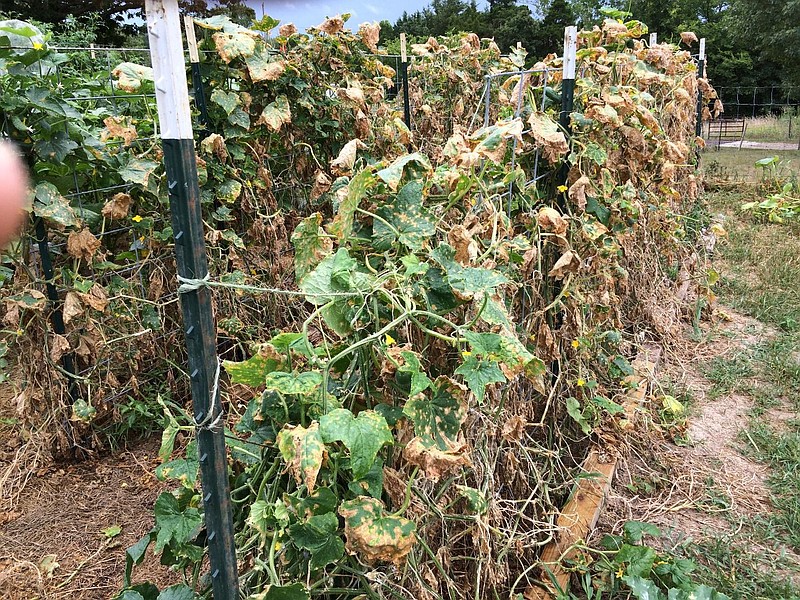Q. What's happening to my cucumbers (see photo)? Can I do anything to save them?
A. You have a foliar disease ripping through your cucumbers. It is likely anthracnose, but it could also be powdery mildew (or both). You need to apply a broad spectrum fungicide. The best is to do a combo of both a Copper product (Bonide is a good one) and one with the active ingredient chlorothalonil (Daconil fungicide is commonly at retail outlets). Include a spreader sticker. You would want to apply it weekly for three to four weeks. The damaged foliage won't recover, but new foliage should fare better. With that you may continue to get some cucumbers through September.
Cucurbit disease alert: Melons, cucumbers, summer squash (zucchini) and watermelons all are likely to get foliar diseases with the recent weather and the forecast conditions. Watch the foliage for spots, and if they occur, apply fungicide to keep the vigor up on plants you want to continue doing well.
Q. I got some manure in, and now my vegetable garden has this new weed, which has been identified as Palmer amaranth. What can I do to keep it from spreading?
A. Palmer amaranth is a very difficult weed, and if you can stop it from going to seed that would be excellent. Hand weed it as best you can for this year. In the spring, can use Preen herbicide to suppress this weed's emergence through early/mid-summer. Be sure to pay special attention to the label of Preen, as for vegetables it is different than for flowers. By July and August, it will likely break through, and removing it is the best option. One can spot treat these with an herbicide with active ingredient glyphosate and labeled for vegetables. However, much of the pigweed group, and specifically Palmer amaranth, is now resistant to glyphosate. So if you spot treat it, and it doesn't readily die, it will need to be hand removed.
Q. I have these tiny bright orange bugs all over some milkweed. What are they?
A. Those are aphids, which many people don't know come in such a variety of colors. While green is most common, yellow, black and red can often be found. This bright orange one always seems to arrive in July or August on milkweed reliably each year. A response of many gardeners will be to kill them somehow, but when gardeners grow milkweed, they are generally trying to have food for monarch caterpillars. So spraying with an insecticide is the last thing one would want to do.
So what to do? One option is to just let nature take its course and watch for the other insects to move in, such as ladybugs, green lacewing and parasitic wasps. Hummingbirds will also eat aphids. The plant foliage might get a little messy, as the honeydew that drips from the aphids can cause a black sooty mold to grow on the plant leaves. One trick some gardeners have used to reduce aphids is to spray them off with a hard blast of water. While effective, it can be a bit time consuming if on much of the growth. A good aspect is it is harmless to all these beneficial organisms.
Q. Are you finding Japanese beetles are attacking different plants this year? A colleague said they were eating all his sweet corn, hops and soybeans.
A. Japanese beetles feed on a wide range of plants, and those three are on the list. For sweet corn, they feed on the silks. Japanese beetle numbers are dramatically down this year, with the drought of 2018 being cited as the most likely contributing factor (a sharp drop followed the 2012 drought). We'll have to wait until next year to see if this was a one year reduction or if it will be long term.

